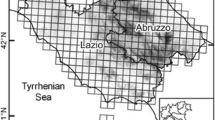Summary
The theory of animal community organization has been dominated by general models based on the Lotka-Volterra equations. The predictions of these models are difficult to test in particular situations. Moreover, a great deal of ecological information is incommensurate with the data requirements of these models. A different approach to community organization addresses the “ecosystem assembly problem”. This problem is defined to be that of constructing an algorithm which assembles a subset of a species pool in a specified environment.
A model of ecosystem assembly, based on generative grammars as used in theoretical linguistics, is described. It was constructed from and validated with data collected by D.H. Morse on a guild of foliage-gleaning birds inhabiting spruce forests on islands off the coast of Maine. The data were divided into two groups. One group, from the years 1967–1970, was used for model construction; the second group, from 1971–1975, was used to validate the model.
The model has two major components. One component inserts species onto islands according to the microhabitat used by each species and the resources available on each island. A second component deletes those inserted species from islands on which they were not observed to occur during 1967–1970. This component is composed of deletion rules that remove species depending on (a) their sizes and resource requirements, (b) the sizes and resource requirements of other species present in the ecosystem, and (c) the structure of the vegetation on the islands. Model validation was performed by comparing the predicted distributions of species against observed distributions not used in model construction. Model accuracy for the later data (1971–1975) was slightly higher than for the earlier data (1967–1970), approximately 88% and 84%, respectively.
The behavior of the model was investigated with several simulations. These included the effects of the removal of certain deletion rules and the effects of the application of the rules without regard to their order. Other simulations demonstrated the application of the model to the prediction of the effects of habitat manipulation and the removal of particular species from the species pool.
Similar content being viewed by others
References
Abbott I (1980) Theories dealing with the ecology of landbirds on islands. Adv Ecol Res 11:329–371
Balda RP (1975) Vegetation structure and breeding bird diversity. In: DR Smith (ed), Proceedings of a symposium on the management of forest and range habitats for nongame birds. USDA Forest Serv Gen Tech Report WO-1, pp 59–80
Chomsky N (1957) Syntactic structures. Mouton Publishers. The Hague
Cody ML (1978) Habitat selection and interspecific territoriality among the sylviid warblers of England and Sweden. Ecol Monogr 48:351–396
Connell JH (1961) The influence of interspecific competition and other factors on the distribution of the barnacle Chthamalus stellatus. Ecology 42:710–723
Connor EF, Simberloff D (1979) The assembly of species communities: Chance or competition? Ecology 60:1132–1140
Emlen JT (1977) Land bird communities of Grand Bahama Island: The structure and dynamics of an avifauna. Ornithol Monogr 24:1–129
Haefner JW (1977) Generative grammars that simulate ecological systems. In: GS Innis (ed), New directions in the analysis of ecological systems. Simulation Councils, Inc., La Jolla CA. pp 185–211
Haefner JW (1978) Ecosystem assembly grammars: Generative capacity and empirical adequacy. J theoret Biol 73:293–318
Haefner JW (1980) Two metaphors of the niche. Synthese 43:123–153
James FC (1971) Ordinations of habitat relationships among breeding birds. Wilson Bull 83:215–235
MacArthur RH (1958) Population ecology of some warblers of northeastern coniferous forests. Ecology 39:599–619
May RM (1973) Stability and complexity in model ecosystems. Princeton University Press, Princeton, NJ
Morse DH (1967) Competitive relationships between Parula Warblers and other species during the breeding season. Auk 84:490–502
Morse DH (1971) The foraging of warblers isolated on small islands. Ecology 52:216–228
Morse DH (1973) The foraging of small populations of Yellow Warblers and American Redstarts. Ecology 54: 346–355
Morse DH (1977) The occupation of small islands by passerine birds. The Condor 79:399–412
Morse DH (1980) Foraging and coexistence of spruce-woods warblers. The Living Bird 18:7–26
Nagel E (1961) The structure of science. Harcourt, Brace, and World, Inc, NY
Niemi GJ, Pfannmuller L (1979) Avian communities: approaches to describing their habitat associations. In: RM DeGraaf and KE Evans (eds), Proceedings of a workshop on the management of northcentral and northeastern forests for nongame birds. USDA For Serv Gen Tech Report NC-51, pp 154–178
Noon BR, Able KP (1978) A comparison of avian community structure in the northern and southern Appalachian Mountains. In: RM DeGraaf (ed), Proceedings of a workshop on the management of southern forests for nongame birds. USDA Forest Serv Gen Tech Report SE-14, pp 98–117
Pianka ER (1974) Niche overlap and diffuse competition. Proc Nat Acad Science (USA) 71:2141–2145
Pielou EC (1977) Mathematical ecology. John Wiley and Sons, NY
Rabenold KN (1978) Foraging strategies, diversity, and seasonality in bird communities of Appalachian spruce-fir forests. Ecol Monogr 48:397–424
Robbins CS, Bruun B, Zim HS (1966) Birds of North America. Golden Press NY
Roughgarden J (1979) Theory of population genetics and evolutionary ecology: An introduction. MacMillan Publishing Co., NY
Sabo SR, Whittaker RH (1979) Bird niches in a subalpine forest: An indirect ordination. Proc Natl Acad Sci (USA). 76:1338–1342
Schoener TW (1976) Alternatives to Lotka-Volterra competition: Models of intermediate complexity. Theoret Popul Biol 10:309–333
Willson MF (1974) Avian community organization and habitat structure. Ecology 55:1017–1029
Yeaton RI, Cody ML (1974) Competitive release in island song sparrow populations. Theoret Popul Biol 5:42–58
Author information
Authors and Affiliations
Rights and permissions
About this article
Cite this article
Haefner, J.W. Avian community assembly rules: The foliage-gleaning guild. Oecologia 50, 131–142 (1981). https://doi.org/10.1007/BF00348027
Received:
Issue Date:
DOI: https://doi.org/10.1007/BF00348027




